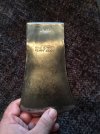The best I've found is Brownell's Cold Blue, it's called Oxpho Blue. You can also use a browning solution if you want a brownish color instead of dark blue/black color. I have used Birchwood Casey's Plum Brown. You have to heat the metal up before applying, but it won't be near enough to screw up the heat treat. I like plain a plain old silver finish so I just use oil to protect the metal. Fortunately I live in a dry climate so rust isn't as big of an issue as other places.
Even if it doesn't require that much heat I'll probably still avoid that one, I'm still wicked cautious when I'm using power tools so I don't mess up the temper. But I'll give one of them a shot, to me it depends on the head, some of them I prefer with a nice patina on it and then some I prefer nice and cleaned up and silver. Although I never go as far as to put a mirror polish on them, it does look cool sometimes but it's a total waste of you're ever going to use it and even if it's a wall hanger I just prefer how it looks when it's cleaned up but not going that far with it.


